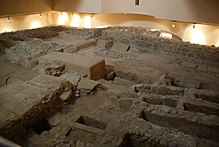Abyla
 Ruins of an early Christian basilica in Ceuta | |
| Alternative name | Septem, Abyla |
|---|---|
| Location | Ceuta, Spain |
| Coordinates | 35°53′18″N 5°18′56″W / 35.888333°N 5.315556°W |
Abyla was the pre-Roman name of Ad Septem Fratres (actual
Names
The name Abyla is said to have been a Punic name ("Lofty Mountain"[1] or "Mountain of God") for Jebel Musa,[2] the southern Pillar of Hercules.[3] It appears in Greek variously as Abýla (Ἀβύλα), Abýlē (Ἀβύλη), Ablýx (Ἀβλύξ), and Abílē Stḗlē (Ἀβίλη Στήλη, "Pillar of Abyla")[3] and in Latin as Mount Abyla (Abyla Mons) or the Pillar of Abyla (Abyla Columna).
The settlement below Jebel Musa was later renamed for the seven hills around the site, collectively referred to as the "Seven Brothers"
History
Punic

The
Mauretanian
After the
Roman
Rome began exerting increasing control over the region, though, first through traders and advisors and then—particularly after
's reigns are attested in funerary inscriptions found around the Septem basilica.Controlling commercial and military access to the
Around AD 200, the
Septem was an important Christian center by the 4th century; one of the basilicas from this time has recently been rediscovered.[9]) In the late 4th century, under Theodosius I, the city still had 10,000 inhabitants, nearly all Christian and Latin-speaking.[10][11]
Vandal
Septem fell to the Vandals in 426.[12]
Byzantine
By the time of
Muslim
There are no reliable contemporary histories concerning the end of the
After the death of Julian, sometimes also described as a king of the
Septa subsequently remained a small village of Muslims and Christians surrounded by ruins until its resettlement in the 9th century by Mâjakas, chief of the Majkasa Berber tribe, who started the short-lived Banu Isam dynasty.[13] The continuing existence of an embattled Christian community is attested by the martyrdom of St. Daniel Fasanella and his Franciscans in 1227;[14] it subsequently survived until the town's capture by the Portuguese reëstablished the Roman Catholic Diocese of Ceuta on 4 April 1417. The Ceuta Cathedral was then raised on the site of old Septem's 6th-century church.[15]
See also
- Ceuta
- Tingis & Mauretania Tingitana
- Tamuda
- Rusadir
References
Citations
- ^ Cauvin & al. (1843).
- ^ Bonney & al. (1907), p. 26.
- ^ a b c Smith (1854).
- ^ a b Smedley & al. (1845), p. 49.
- Geography, IV.i.5.
- ^ In, e.g., Pomponius Mela.
- ^ Dyer (1873).
- ^ Cravioto, Enrique. "La circulación monetaria alto-imperial en el norte de la Mauretania Tingitana"
- ^ Roman basilica article, with related video
- ^ Theodore Mommsen. The Provinces of the Roman Empire, "Africa".
- ^ Christianity of Romanized Berbers
- ^ Maros Pérez, Alváro, Septem en la Tardoantigüedad (PDF), p. 23, archived from the original (PDF) on 22 April 2016
- ^ Hamilton Alexander Rosskeen Gibb; Johannes Hendrik Kramers; Bernard Lewis; Charles Pellat; Joseph Schacht (1994). "The Encyclopaedia of Islam". Brill. p. 690.
- ^ San Daniele Fasanella martyrdom (in Italian)
- ISBN 978-0-9543335-3-9. Retrieved 8 July 2013.
Bibliography
- Bonney, Thomas George; et al. (1907), The Mediterranean: Its Storied Cities and Venerable Ruins, New York: James Pott & Co.
- Cauvin, Joseph; et al., eds. (1843), "Abila", Lempriere's Classical Dictionary..., London: Longman, Brown, Green, & Longmans.
- Conant, Jonathan. Staying Roman : conquest and identity in Africa and the Mediterranean (pp. 439–700). Cambridge New York: Cambridge University Press. ISBN 0521196973. Cambridge, 2012
- Cravioto, Enrique. La circulación monetaria alto-imperial en el norte de la Mauretania Tingitana. Universidad de Castilla-La Mancha. Cuenca, 2007.
- Dyer, Thomas H. (1873), "Septem Fratres", A Dictionary of Greek and Roman Geography..., vol. II, London: John Murray, p. 965.
- Mommsen, Theodore. The Provinces of the Roman Empire, Section Africa. Ed Barnes & Noble. New York, 2005
- Noé Villaverde, Vega. Tingitana en la antigüedad tardía, siglos III-VII: autoctonía y romanidad en el extremo occidente mediterráneo. Ed. Real Academia de la Historia. Madrid, 2001 ISBN 8489512949
- Robin, Daniel. Faith, Hope and love in the early churches of North Africa (This Holy Seed). Tamarisk Publications, Chester, United Kingdom ISBN 978 0 9538565 3 4
- Smedley, Edward; et al., eds. (1845), "Mauritania", Encyclopaedia Metropolitana..., vol. XXII, London: B. Fellowes & al., pp. 48–49.
- Smith, Philip (1854), "Abyla", Dictionary of Greek and Roman Geography..., London: Walton & Maberly.
- Talbi, Mohammed. Le Christianisme maghrébinin "Indigenous Christian Communities in Islamic Lands". M. Gervers and R. Bikhazi. Toronto, 1990.



